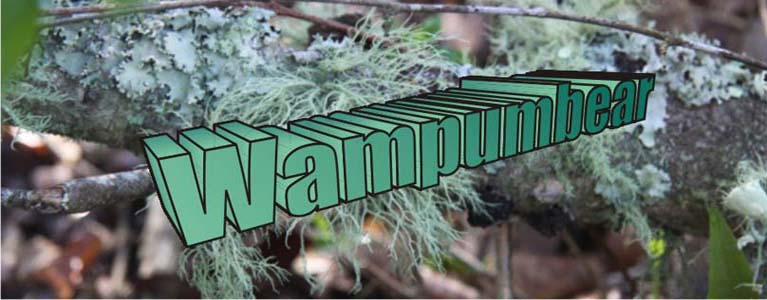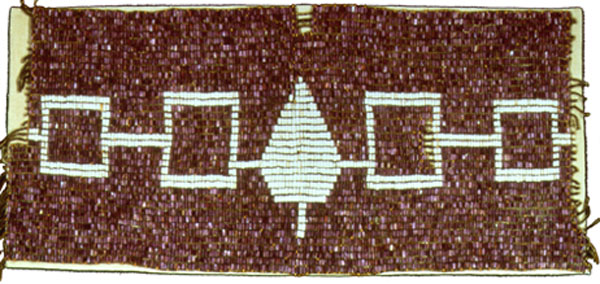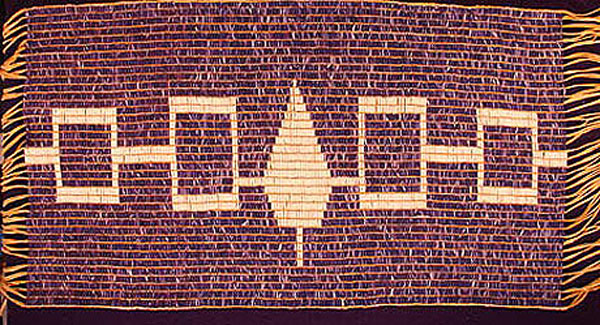 |
Photographs (left to right): Burgess Falls, Tennessee; Athens Botanical Gardens, Georgia; Oyster Fungus, Athens Botanical Gardens, Georgia
Wampum Belt Archive
Hiawatha Belt
Original NYSM
Reproduction (R. D. Hamell)
Original Size: |
Length: 21.5 inches. Width: 10.5 inches. Rows wide: 38 by 192 long: Total: 7,296 beads. |
Reproduction: |
Beaded length: 31.25 inches. Width: 17.25 inches. Total length with fringe: 55.0 inches |
Beads: |
Rows: 192 by 38 beads wide. Total 7,296 beads. |
Materials: |
Warp: leather. Weave: artificial sinew. |
Arm/Head Band
Description (Clarke):
This is in the form of a beaded mat on which a symbolic design in white beads has been worked in along its length, consisting of two hollow squares on either side of a figure of a heart (tree?), which occupies the center. It is one of the most important and valuable Iroquoian wampum belts in existence and is considered the original record of the formation of the Iroquois League when representatives sat at the great council to ratify the union of the Five Nations. The exact age of this belt is unknown, but General Carrington has said that (Beauchamp, '01, p. 411) it is "the official memorial of the organization of the Iroquois Confederacy, relating back to the middle of the 16th century." It is referred to (New York State Supreme Court, '00, p. 59) as a "belt of dark wampum beads representing the Confederation organization of the Five Nations under Hiawatha." General John S. Clark, a witness for the plaintiffs in the Thacher case, is quoted as saying (New York State Supreme Court, '00, p. 59) "That it was made at the formation of the League representing the Five Nations united together by white lines through the central part of the Nations." The "reading" of this belt was made by Daniel and Thomas La Forte at Onondaga Castle, July 19 and August 1, 1898, as follows: (Beauchamp '01, p. 420) "One heart of the Five Nations -that if any hurt of any one animal would pierce that heart then they would all feel it-all of the Five Nations. This was in Hiawatha's belt. That they are a united people. This is the original Hiawatha belt-a record of the first agreement to take the League." Under section 60 of the original Iroquois Code (Emblematical Union Compact) of the Great Binding Law, (Parker, '16, p. 47) reference is made to the interpretation of the designs on this belt: The first of the squares on the left represents the Mohawk Nation and its territory; the second square on the left and the one near the heart, represents the Oneida Nation and its territory; the white heart in the middle represents the Onondaga Nation and its territory; and also means that the heart of the Five Nations is single in its loyalty to the Great Peace, that the Great Peace is lodged in the-heart (meaning the Onondaga Confederate Lords), and that the Council Fire is to bum there for the Five Nations, and further, it means that the authority is given to advance the cause of peace whereby hostile nations out of the Confederacy shall cease warfare; the white square to the right of the heart represents the Cayuga Nation and its territory and the fourth and last square represents the Seneca Nation and its territory. White shall here symbolize that no evil or jealous thoughts shall creep into the minds of the lords while in council under the Great Peace. White the emblem of peace, love, charity and equity surrounds and guards the Five Nations. In reversing the belt, the figure of the "heart" in the center assumes the appearance of a tree and at the same time brings the geographical position of the Five Nations in the correct order on the belt. A figure of a tree might well represent the Onondaga Nation as the Onondagas were designated to keep the Council Fire and it was under the Great Tree of Light that the nations met in council.Quote Bardeau (2011)
This belt records the formation of the Hodinöhsön:ni´. It is one of the founding belts of the Great Law of Peace. The center represents the Onondaga Nation as the Keepers of the Central Fire of governance and the heart of the League’s unity as well as the tree symbolizing the Great Peace. On each side are the other united nations: Mohawk and Oneida on the east (the Mohawks being the Keepers of the Eastern Door); and the Cayuga and Seneca on the west (the Senecas being the Keepers of the Western Door).
Stolle, Nickolaus (2016): Bequest of Emma T. Thacher 1927, purchased by her husband, John B. Thacher 1893. Acquired by Henry Carrington from THomas Webster, an Onondaga in 1891. Repatriated 1989.
Reference:
Bardeau, Phyllis Eileen Wms. 2011. Definitive Seneca: It's In The Word. Jaré Cardinal, editor. Seneca-Iroquois Museum Publisher, Salamanca, New York, 443pp.
Clarke, Noah T. 1931 New York State Museum Bulletin No. 288, Fig. 19.
Stolle, Nickolaus. 2016. Talking Beads: The history of wampum as a value and knowledge bearer, from its very first beginnings until today. Hamburg, Germany. ISSN 1437-7837
 |
 |
 |
 |
 |
 |
 |
 |
|---|

